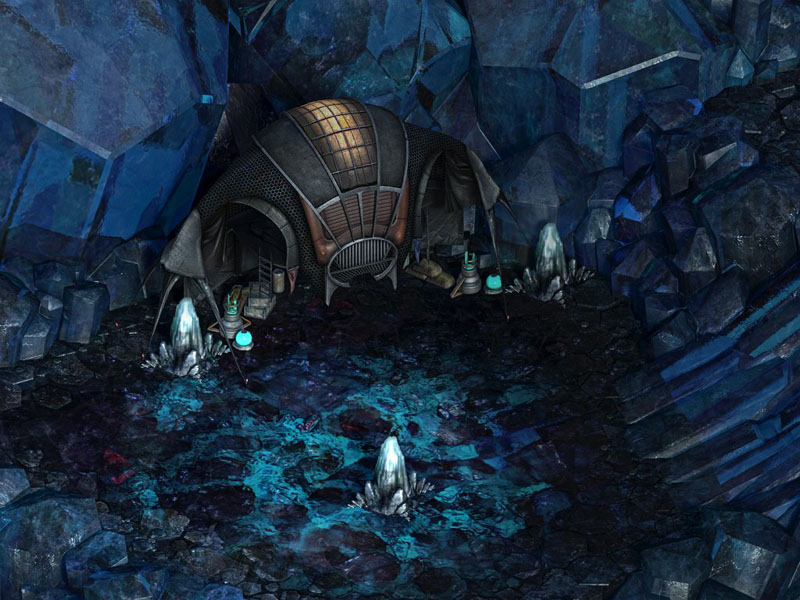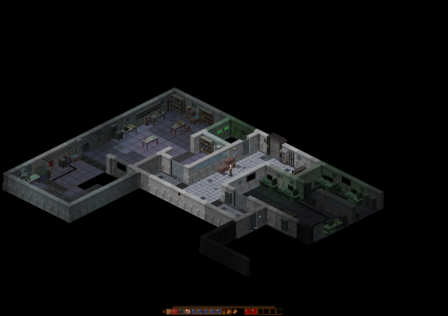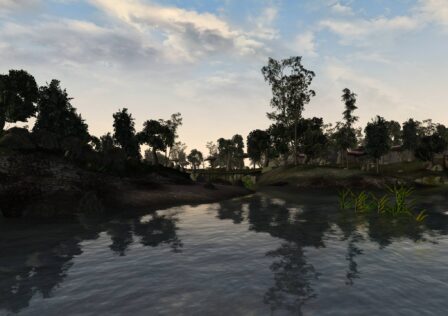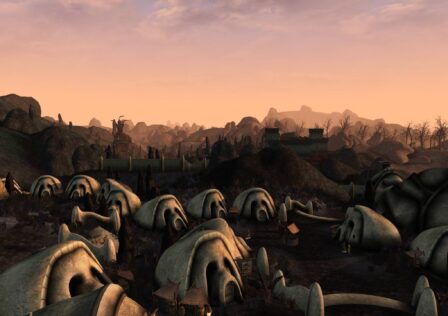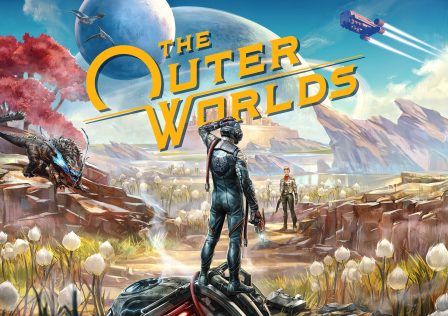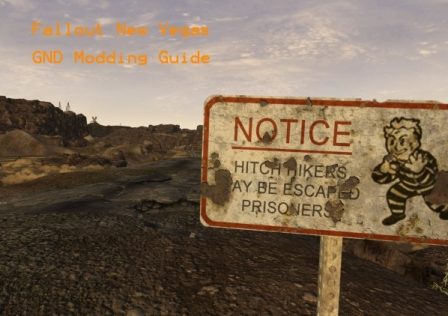Torment: Tides of Numenera is InXile’s upcoming RPG. They released Wasteland 2 last year, which turned out to be one of the best RPGs not only in 2014 but in recent years. It was a throwback to classic RPGs like its predecessor as well as Fallout, Fallout 2, and Fallout: Tactics, and stands out as being one of very few hardcore modern RPGs. Wasteland 2 presents a thoughtful, very significant skill system, a complex attribute system, party dialogue system similar to Neverwinter Nights 2: Storm of Zehir, and plenty of freedom to role-play in the story, leading to many different outcomes and even premature endings. InXile did a fantastic job with Wasteland 2.
But like every other game, Wasteland 2 has its faults. It has serious pacing issues; we found it to be addicting for the first 35-40 hours or so, but then it dreadfully drags on later in the game, with main quests being reduced to menial tasks. Wasteland 2 also lacks a strong story; although the dialogue is often witty and humorous, it is not a story driven game and at some point, as the game drags on and starts to feel monotonous, you will begin to question the purpose of playing the game especially when there is no complex story to pursue and no well developed characters that you can care for.
Like Wasteland 2, Torment: Tides of Numenera is a spiritual successor to classic RPGs: in this case, as the name implies, it is a spiritual successor to Planescape: Torment, which stands as one of the best RPGs of all time, and is still by far the most well-written game of all time. We have such high hopes for the game that it was named our most anticipated game of 2015 in our 2014 game of the year ceremony. Being the hardcore RPG fans that we are, we have a very thorough wishlist, and clear ideas of what InXile needs to do and what they need to avoid when developing the game.
Do’s
Before making our suggestions, we have to be clear about several things.
- We actually understand the type of game Torment: Tides of Numenera is supposed to be: a story-driven hardcore RPG inspired heavily by Planescape: Torment. This is vital: you can’t make suggestions for something if you don’t understand it, and this is overlooked by just about every other gaming website.
- We have no experience in Monte Cook’s Numenera setting, so we won’t make specific suggestions about setting or rules.
- We adore hardcore RPGs with complex rulesets, like D&D games and the classic Fallout games. So for the most part, we are on the same page as InXile, and we understand their game design choices.
Not too long ago InXile released the following gameplay teaser.
Having watched that, we will now proceed with a list of things we’d like to see in Torment: Tides of Numenera.
This was an obvious one. Planescape: Torment is known for one thing above all others, and that is its writing quality. It tells one of the most original, complex stories in video game history, and does it exceptionally well. Its writing quality is closer to that of great novels instead of video games, and despite the quality of writing, the story and dialogue can branch out considerably like every story-driven RPG should.
Torment: Tides of Numenera needs to live up to this example that Planescape set, because no other game has. Neverwinter Nights 2: Mask of the Betrayer tried, and came close, so at the very least its writing quality needs to be on this level. The problem with Mask of the Betrayer is that the story progression is more linear than that of Planescape; in order for Torment: Tides of Numenera to truly stand out over every other game, it needs to branch out even more and strongly react to the player’s dialogue choices.
During 2014 we saw the release of many large scale games, larger than ever before. The three best RPGs of the year are solid examples: Dragon Age: Inquisition, Divinity: Original Sin, and InXile’s own Wasteland 2. When you compare these games to their predecessors, you will see that these modern counterparts are significantly larger in scale. Divinity: Original Sin has huge areas, much bigger than the classic RPGs (excluding open world ones like The Elder Scrolls III: Morrowind) and both Wasteland 2 and Divinity: Original Sin are significantly longer than the classics. Planescape: Torment is only around 30-40 hours long unless you waste a lot of time doing repetitive, menial tasks. Both Baldur’s Gate games and both Fallout games are also significantly shorter and smaller than the 70+ hour Wasteland 2 and Divinity: Original Sin.
Dragon Age: Inquisition is on a level of its own when it comes to scale. All of these RPGs have a hub based non-linear design, but many of Inquisition’s areas approach the size of an entire open world game.
The point is, last year’s RPGs were bigger than ever before. We never saw this type of RPG, the type that Torment: Tides of Numenera is, be this expansive. Obviously since Torment: Tides of Numenera is a crowd-funded game we aren’t expecting Dragon Age: Inquisition’s size and scale, but hopefully it at least follows Wasteland 2’s example. We want to see significantly larger areas than what Planescape: Torment offers, and it would be nice if it’s a longer game too… as long as it doesn’t drag on like Wasteland 2 does. It should be expansive, large scale, and open, but not empty. Please use an open level design thoughtfully, like Dragon Age: Inquisition or even Baldur’s Gate II.
We don’t want looting to be required, but we would like to see a diverse set of equipment and loot that isn’t just a waste of time. If there are hidden areas like in Wasteland 2, there should be a chance of finding good loot in them. We feel that loot should be randomized in non-linear RPGs as well.
In terms of equipment, we really love the amount of weapon categories that both Neverwinter Nights games have, so seeing something similar along with several different armor classes would be ideal.
Building off of our previous point, every RPG of this type has special artifacts, whether it’s unique weapons, armor, or accessories like amulets and rings. Personally my favorite artifact in RPG history has to be the Silver Sword of Gith from Neverwinter Nights 2 and Neverwinter Nights 2: Mask of the Betrayer. It is a universal sword which means it can be wielded by both shortsword, longsword, and greatsword wielding warriors. It has no race or class restrictions and needs no weapon proficiency feat. But it’s more than just a sword: ignoring its plot importance, in Neverwinter Nights 2 this sword is not only powerful with its +3 enchantment bonus, it has many special abilities such as Blade Storm which breaks the sword blade up into shards, and fires these shards at an area of enemies, damaging and possibly knocking them all down, but it can instead target only a single enemy, adding to its versatility. Another ability is Shard Barrier, which breaks the blade up into shards which form a barrier around the person wielding it, damaging anyone who approaches. Uses are not quite unlimited, and it has many other abilities, and new ones in Mask of the Betrayer, which you can read about here.
We aren’t asking for the Silver Sword of Gith to be included in Torment: Tides of Numenera, since that makes no sense. What we are asking for is worthwhile special artifacts, sort of like how the Silver Sword of Gith is a worthwhile special artifact. Looking at Dragon Age 2 and The Elder Scrolls V: Skyrim as other examples, their artifacts have special meshes but in terms of gameplay, they aren’t special. Most of them do not have unique abilities, nor are they more powerful than regular items. Retrieving these mediocre artifacts is not rewarding. Most Skyrim players will find themselves using regular weapons and armor instead of special ones, because Skyrim’s artifacts are weak. But artifacts are artifacts for a reason, they should have unique advantages, distinct disadvantages, but should be more powerful than regular counterparts of the same level.
This is something cRPG fans are used to, and it’s something we’d love to see in Torment: Tides of Numenera. Many RPGs give us HUD scaling and the ability to move around or close HUD elements. Neverwinter Nights 2 and Dragon Age: Origins are probably the best examples. We at GND-Tech hate intrusive HUD’s, and want to minimize it as much as possible. While it’s true that an RPG like this can’t have an extremely barebones HUD like an Elder Scrolls game can, if Torment wants to be like some of its successful predecessors then it should give the player some control over the HUD.
The vast majority of great RPGs have good mod support, even dating back to the early days. Fallout, Fallout 2, Baldur’s Gate, Baldur’s Gate II: Shadows of Amn, Planescape: Torment, Neverwinter Nights, Neverwinter Nights 2, Dragon Age: Origins, Dragon Age 2 (not a great game but it’s a modern RPG with mod support), and Divinity: Original Sin all have excellent mod support. Many of them have SDKs so we can create our own campaigns.
As far as we know, Wasteland 2 does not have extensive mod support. It’s a Unity engine game so great mod support should be possible, so this is a minor cause for concern for Torment: Tides of Numenera. Mods only increase longevity, especially for games like this. What’s the harm in user-made content packs?
Don’ts
There are many traps that InXile should avoid when developing Torment: Tides of Numenera, and we feel our suggestions here are less obvious and more important than many of the Do’s.
There are more than enough dumbed down, oversimplified RPGs, which are meant to appeal to the widest audience possible (including young teens, despite the fact that they usually have age 17+ ratings). The Witcher games are the best examples, which are best described as “fringe-RPGs” since they lack any sort of gameplay diversity and for a story-driven RPG, their story progression is too linear and player choice is not as big a factor as they make it out to be. Plus, the gameplay in The Witcher 2 is just hack-and-slash with five very basic spells, and no other playstyles but this one. The leveling and ruleset in general are extremely dumbed down compared to something like Dungeons & Dragons.
As much as we love Dragon Age: Inquisition, we could not ignore that it is dumbed down compared to Dragon Age: Origins in some ways, specifically the automatically increasing attributes when leveling up, the removed AI tactics system, and the reduced diversity (since modern gamers are afraid of diversity and choice). Even Dragon Age: Origins is dumbed down in some ways compared to its spiritual predecessors like Neverwinter Nights and Baldur’s Gate, but it remains complex enough for most and its AI tactics system still reigns supreme.
We want a complex ruleset, and we want the same amount of gameplay diversity that many of the classic RPGs offered. Wasteland 2 does it right, with its full-fledged rule system and in-depth role-playing.
The image above shows the first character creation scene in Wasteland 2. The game has seven attributes, and does not give the player many starting points for them. You don’t get attribute points every time you level up, it’s rather rare like in Dungeons & Dragons games. All of these attributes impact the “Derived Stats” and you can see just how many there are, and they are all extremely important.
Look at the amount of skills Wasteland 2 offers. Twenty nine skills. They are all very useful, except perhaps Toaster Repair. All of the general skills turn up in gameplay, and many in-game scenarios call upon several different general skills, not just one, so that it provides alternatives. Look, for example, at the dialogue skills under general skills: “Hard Ass” which refers to intimidation, “Kiss Ass” which refers to a more polite persuasion technique, and “Smart Ass” which refers to outsmarting others in dialogue. All three are strongly present throughout the game, and sometimes you can use one instead of another. “Brute Force” can often be used in place of “Lockpicking” but there are of course consequences. The point is, the game has many skills and all of them are useful. This also applies to Fallout and it’s “S.P.E.C.I.A.L.” ruleset, and Dungeons & Dragons.
As mentioned earlier, we don’t know much about Monte Cook’s Numenera game, but since it is a tabletop RPG we will assume it is at least as complex as the above rules. All we ask is not to leave too much of that complexity out of Torment: Tides of Numenera. Its ruleset should be at least as complex as the above games, it should have a diverse skill set that is actually used throughout the game (in similar fashion to Wasteland 2 and other RPGs), and it should also have diverse classes if it is going to have a formal class system like most other RPGs. Neverwinter Nights 2 for example has 15 base classes, each one being substantially different than one another and only six have fundamental similarities (Wizard and Sorcerer, Cleric and Favored Soul, Barbarian and Fighter). Different classes rely on different attributes, and each class has specific skill focus. Each one has an abundance of unique abilities, and so do all 24 of the prestige classes, so each and every class and prestige class feels fresh and very different from one another.
We don’t need that many classes, but it would be nice to have more than three like Dragon Age is limited to. Divinity: Original Sin has 11 classes, that is plenty for us. Again we don’t know much about Numenera, but if it is a class-based RPG then please don’t exclude too many for the sake of appealing to casuals who are overwhelmed by choice and character creation (after all, games like this usually have pre-made characters which is a much better solution to character creation complexity than dumbing down the rules and character creation).
Of course, we’re really preaching to the choir here. Look at what InXile did with Wasteland 2, and look at the positive reception it got. Look at their stance on the RPG genre. Torment: Tides of Numenera is most likely not going to disappoint us in this regard.
Lately we have seen many RPGs turn back the clock and deliberately resemble RPGs from the late 90s. Examples include Divinity: Original Sin, Wasteland 2, Shadowrun Returns, the upcoming Pillars of Eternity, and of course Torment: Tides of Numenera. This is fine as long as you understand why the classic RPGs were the way they were, and as long as you emulate the right things and not the wrong things.

The classic RPG model which Torment: Tides of Numenera is trying to resemble, includes the aforementioned rule complexity and gameplay diversity that we love, which is definitely something that most if not all RPGs should seek to provide. It also includes limitations to 2.5D rendering and isometric viewpoint, and this is something that should be avoided.
The classic RPGs like Fallout, Baldur’s Gate, and Planescape: Torment feature an isometric viewpoint because they wanted to resemble tabletop RPGs. In real life, when playing a tabletop RPG, you are looking at an isometric angle like in these video games. The reason these games were limited to 2.5D rendering is tied to the technology at the time: these games are from the late 90s you see, so real time 3D graphics didn’t have the detail that they wanted. It wasn’t possible, so they chose 2.5D, because 2.5D is meant to resemble 3D. We applaud this decision.
But guess what? It’s 2015 now. Such technological limitation no longer exists. Early in the 21st century, developers like BioWare, Obsidian, Bethesda Game Studios, and even Interplay/Black Isle Studios (which InXile stems from), tried to take advantage of newer technology and detailed 3D rendering. This is evident in games like Neverwinter Nights (BioWare), Neverwinter Nights 2 (Obsidian), Star Wars: Knights of the Old Republic (BioWare), Star Wars: Knights of the Old Republic II – The Sith Lords (Obsidian), The Elder Scrolls III: Morrowind (Bethesda), and the unreleased Baldur’s Gate III: The Black Hound (Interplay/Black Isle Studios). All of which are 3D games, and both Neverwinter Nights games feature unrestricted camera control allowing for isometric view, third-person view, and anything in between. This is the right way to do it, because it satisfies everyone: those who prefer third person and those who prefer isometric. Dragon Age: Origins might be the most recent RPG to fully satisfy both crowds. It is unfortunate that Torment: Tides of Numenera is not one of such games, so InXile has already fell into this trap. They have already done this “don’t” and we don’t see any good reason for it.
Wasteland 2, InXile’s most recent game, is 3D. It is limited to isometric viewpoint, but this is only a slight hindrance because it is a turn-based game so combat would be awful in third person. Dialogue and exploration however would be more immersive for most gamers in third person, but the option for 100% isometric gameplay should remain. Truthfully, the camera should have unrestricted movement and scrolling, similar to the Neverwinter Nights games, Dragon Age: Origins, and Dragon Age: Inquisition. We should be given the ability to move the camera wherever we want, play in any way we want. This satisfies everyone and is easily possible in a 3D game like Wasteland 2.
Very few people honestly prefer 2.5D over 3D, and those that do prefer 2.5D do so for only confused reasons. They are not aware that the classic RPGs were rendered in 2.5D due to technological limitation, and they generally refuse to accept this answer for whatever reason (maybe they would rather believe the classic RPGs are perfect). They don’t seem to be aware that 2.5D is meant to resemble 3D. It’s a poor man’s design, but Torment: Tides of Numenera gathered significantly greater crowd fundings than Wasteland 2: the latter raised $2,933,252 while the former raised $4,787,293 and counting. These figures can be found on InXile’s website and also the Kickstarter page for both games (but the Kickstarter page for Torment is outdated).
It doesn’t make much sense to play a story-driven role-playing game in isometric viewpoint the entire time. It makes sense for setting up battles, but in a role-playing game you are meant to be in someone’s shoes, and story-driven games are much more powerful when you are looking a person in the eye when talking to them, rather than controlling everything from above like a God. It is without question that Torment: Tides of Numenera would be a superior game being made in 3D opposed to fake 3D as it currently is, with both isometric viewpoint and third person viewpoint as options to satisfy everyone. A more unrestricted camera mode, like Dragon Age: Inquisition’s tactical camera but improved, would have been a lovely feature as well, since this enables the player to position the camera almost anywhere making it easier to set up battles, and view battles in more cinematic fashion.
But as it stands, the ignorance behind the origins of 2.5D RPGs is being used by InXile as a smokescreen to cut corners, to cut spending. The result of this is yet another 2.5D (fake 3D) RPG in 2015. Even Wasteland 2 suffers from this, by being limited to isometric so that they can render characters with less detail than a 10 year old 3D game, and so that they didn’t have to render skies or ceilings. But Torment: Tides of Numenera suffers the most. It looks like it will have stunning, magnificent, alien environments. Imagine them in 3D.


Well, keep imagining because it is not going to happen. At least Torment’s 2.5D rendering looks more modern than that of Pillars of Eternity (CGI inspired?), and at least Torment has much more modern animations. Pillars of Eternity literally looks like Obsidian took an RPG made 15 years ago and scheduled a release for this year. Torment: Tides of Numenera on the other hand looks like a 10 year old RPG with much more modern animations. Either way, making a game in 2.5D in 2015, with the kind of budget they had, is just half-assed. This applies to both Pillars of Eternity and Torment: Tides of Numenera, although Torment is the lesser offender.
We already mentioned the pacing problems with Wasteland 2; it’s over 70 hours long, which would be great if paced well and filled with diverse content. Instead it gets monotonous and rather repetitive, with main quests being reduced to menial tasks, and the game just loses its charm. The player is given little reason to even want to finish at this point, due to the lack of a good story or well developed characters.
If Torment: Tides of Numenera is going to be a long game, it needs to not beat around the bush too much, it can’t drag itself on like Wasteland 2 does. Look at any long story, whether it’s a video game, a film, or a novel; significant events happen throughout to keep it from feeling monotonous. Torment: Tides of Numenera has the advantage of being heavily story-driven so hopefully players will feel compelled to play all the way through. Planescape: Torment for example builds up an amazing, memorable, and diverse cast, and tells the most marvelous story ever told in a game, so attentive players are going to feel strongly compelled to finish it. It is, however, a relatively short RPG, lasting about 40 hours for a very thorough playthrough.
Dragon Age: Inquisition might be the best example; it can easily last well over 100 hours, but never becomes monotonous due to how diverse the different regions are, and because of the significance and variety in main quests. It builds up to several different climaxes throughout, it paces itself perfectly for its length. Wasteland 2 does not, but Torment: Tides of Numenera needs to.
Conclusion

It is unfortunate that Torment: Tides of Numenera has already violated one of our most significant “Don’ts” but despite this, it remains our most anticipated game of 2015. Its writing needs to live up to the example set by its spiritual predecessor, Planescape: Torment, it needs to be devoid of the pacing issues and late monotonous feel that Wasteland 2 suffers from, and if it really wants to impress, it needs to be expansive and ambitious, since 2014 was full of such RPGs.

